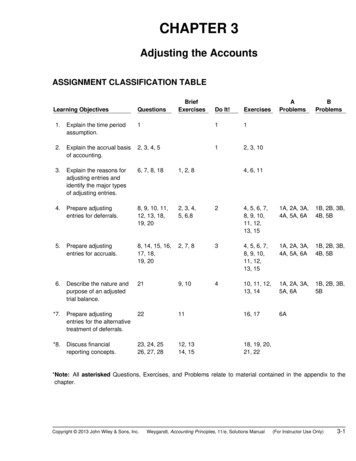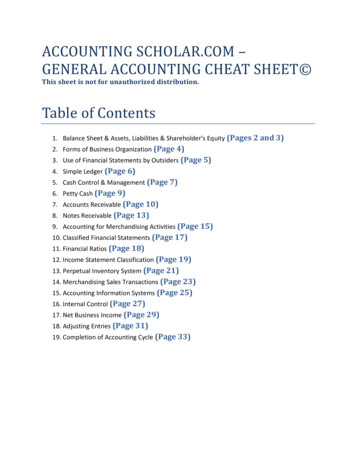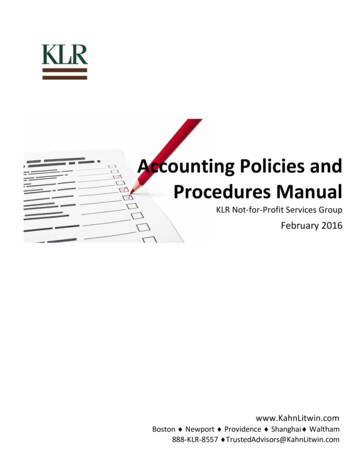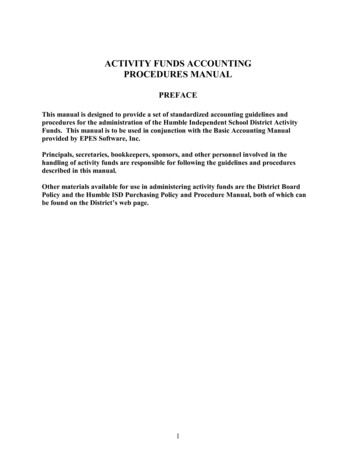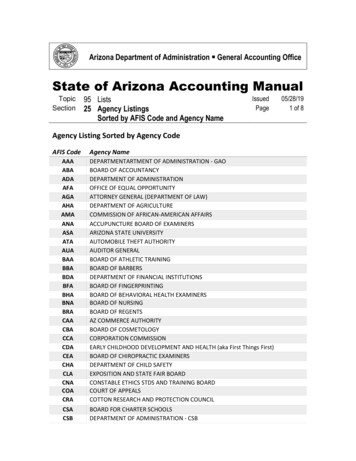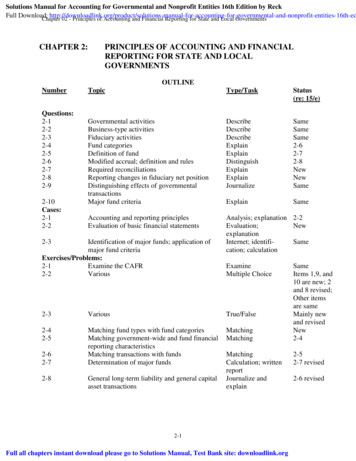
Transcription
Solutions Manual for Accounting for Governmental and Nonprofit Entities 16th Edition by ReckFull fit-entities-16th-edChapter 02 - Principles of Accounting and Financial Reporting for State and Local GovernmentsCHAPTER 2:PRINCIPLES OF ACCOUNTING AND FINANCIALREPORTING FOR STATE AND us(re: 15/e)Governmental activitiesBusiness-type activitiesFiduciary activitiesFund categoriesDefinition of fundModified accrual; definition and rulesRequired reconciliationsReporting changes in fiduciary net positionDistinguishing effects of governmentaltransactionsMajor fund -8NewNewSameExplainSameAccounting and reporting principlesEvaluation of basic financial statementsAnalysis; explanation 2-2Evaluation;NewexplanationInternet; identifiSamecation; calculation2-3Identification of major funds; application ofmajor fund criteriaExercises/Problems:2-1Examine the CAFR2-2VariousExamineMultiple Choice2-3VariousTrue/False2-42-5Matching fund types with fund categoriesMatching government-wide and fund financialreporting characteristicsMatching transactions with fundsDetermination of major fundsMatchingMatching2-62-72-8General long-term liability and general capitalasset transactionsMatchingCalculation; writtenreportJournalize andexplain2-1Full all chapters instant download please go to Solutions Manual, Test Bank site: downloadlink.orgSameItems 1,9, and10 are new; 2and 8 revised;Other itemsare sameMainly newand revisedNew2-42-52-7 revised2-6 revised
Chapter 02 - Principles of Accounting and Financial Reporting for State and Local GovernmentsCHAPTER 2:PRINCIPLES OF ACCOUNTING AND FINANCIALREPORTING FOR STATE AND LOCALGOVERNMENTSAnswers to Questions2-1.Certain core services are provided by most general purpose governments—those relatedto the protection of life and property (e.g., police and fire protection), public works (e.g.,streets and highways, bridges, and public buildings), parks and recreation facilities andprograms, and cultural and social services, among others. Governments must also incurcosts for general administrative support (such as, data processing, finance, and personnel)of its service departments. Core governmental services, together with generaladministrative support, comprise the major part of what GASB refers to as governmentalactivities. The measurement focus and basis of accounting for these activities is on theflow of current financial resources on the modified accrual basis in the governmentalfunds and on the flow of economic resources on the accrual basis in the GovernmentalActivities column of the government-wide financial statements.2-2.The business-type activities of a government include public utilities (such as electric,water, gas, and sewer utilities), transportation systems, toll roads and bridges, hospitals,parking garages and lots, liquor stores, golf courses, airports, and swimming pools,among other activities. Many of these activities are intended to be self-supporting bycharging users for the services they receive. Focusing financial reporting on economicresources recognized on the accrual basis of accounting allows the government todetermine whether charges for services are sufficient to cover the full cost of the activity.This measurement focus and basis of accounting is the same used for reportinggovernmental activities in the government-wide financial statements, but quite differentfrom the current financial resources measurement focus and modified accrual basis ofaccounting used in the governmental funds.2-3.Fiduciary activities of a government involve the government’s discharge of its fiduciaryresponsibilities, either as an agent or trustee, for parties outside the government. Forexample, a government may serve as agent for other governments in the administeringand collecting of taxes. Fiduciary activities are accounted for in agency funds, investmenttrust funds, pension trust funds, and private-purpose trust funds.Fiduciary activities are reported only in the fund financial statements and not in thegovernment-wide financial statements because these resources belong to external parties,not the government. Fiduciary funds use accrual accounting and focus on economicresources, as do business-type activities. However, reporting for fiduciary activitiesdiffers from that for governmental funds since the latter funds focus primarily on thebudget and current financial resources.2-2
Chapter 02 - Principles of Accounting and Financial Reporting for State and Local GovernmentsCh. 2, Answers (Cont’d)2-4.The three categories of funds are governmental, proprietary, and fiduciary. The fundtypes included in each category are shown below:GovernmentalGeneral FundSpecial revenue fundsDebt service fundsCapital projects fundsPermanent fundsProprietaryEnterprise fundsInternal service fundsFiduciaryAgency fundsInvestment trust fundsPension (and otheremployee benefit) trustfundsPrivate-purpose trustfundsThese categories correspond to the three activity categories with the exception thatfinancial information for internal service funds is generally reported in the GovernmentalActivities column of the government-wide financial statements. However, if an internalservice fund predominantly serves an enterprise fund, its financial information is reportedin the Business-type Activities column.2-5.As a fiscal entity, a fund has its own resources and can incur liabilities to be repaid fromthe fund resources. As an accounting entity, the fund has its own self-balancing set ofaccounts.2-6.Governmental funds, the five fund types listed in Illustration 2-3 of the text, focus on theflow of current financial resources. Consequently, these funds use the modified accrualbasis of accounting. Under modified accrual revenues are recognized if the inflow ismeasurable and available to pay current period obligations. Expenditures are recognizedas incurred if they will be paid from available resources.2-7Governmental fund balances represent the difference between currently available assetsof the governmental funds and liabilities to be repaid from those assets. (Deferredoutflows and deferred inflows of resources, if any are reported, also affect fund balance,as discussed in this chapter.) Changes in fund balances reflect revenues and otherfinancing sources inflows and expenditures and other financing uses outflows. Changesin fund balances focus on the flow of current financial resources, recognized on themodified accrual basis of accounting. Net position of governmental activities at thegovernment-wide level reflects the difference between all economic assets and liabilities,both short-term and long-term, recognized on the accrual basis. Changes in net positionreflect the difference between revenues and expenses. Because of the differentmeasurement focuses and bases of accounting, GASB standards require that total fundbalances be reconciled to total net position of governmental activities and that the changein fund balances be reconciled to the change in governmental activities net position. Thereconciliation schedules can be presented on the face of the government-wide statementof net position and statement of activities, respectively, or they can be presented asseparate schedules.2-3
Chapter 02 - Principles of Accounting and Financial Reporting for State and Local GovernmentsCh. 2, Answers (Cont’d)2-8.As explained in Chapter 2, fiduciary fund resources belong to external parties, not thegovernment. Reporting increases (decreases) in fiduciary net position as revenues(expenses) would imply the resources can be (were) used at the discretion of thegovernment. To avoid this impression, GASB standards use the terms additions(deductions) to report increases (decreases) in fiduciary net position.2-9.General Fund:CashOther Financing Sources—Proceeds of 5-Year NoteDebits1,000,000Credits1,000,000Governmental Activities:CashMortgage Note Payable1,000,000General Fund:Expenditures—Capital OutlayCash1,000,000Governmental 01,000,0002-10. GASBS 34 requires that any fund that meets the following relative size criteria bedesignated as major:a.b.Total assets, liabilities, revenues or expenditures/expenses of that governmental or enterprise fund areat least 10 percent of the corresponding element total (assets, liabilities, and so forth) for all funds ofthat category or type (that is, total governmental or total enterprise funds), and (emphasis added)The same element that met the 10 percent criterion in (a) is at least 5 percent of the correspondingelement total for all governmental and enterprise funds combined.In addition to funds that meet these two criteria, the General Fund of a state or localgovernment must always be reported as a major fund. Finally, at its discretionmanagement can report as a major fund any other governmental or enterprise fund that itconsiders of significant importance to financial statement users.Solutions to Cases2-1.A quick look at these financial statements reveals that Ms. Eager has almost noknowledge of GASB reporting requirements. Let’s examine these financial statementsfrom the viewpoint of (a) a local CPA who is considering auditing the town’s financialstatements and (b) a member of the town council or a citizen.2-4
Chapter 02 - Principles of Accounting and Financial Reporting for State and Local GovernmentsCh. 2, Solutions (Cont’d)a. As a CPA knowledgeable about governmental accounting, you should see many redflags regarding this potential audit engagement. Do the financial statements that Ms.Eager has prepared conform to GAAP? The short answer is no! To the CPAcontemplating whether to serve as auditor, these financial statements should set offalarm bells. He or she has only to compare these statements to the variety ofgovernment-wide and fund financial statements required by GASB standards (seeIllustrations A2-1 through A2-11) to realize that they fall far short of what is requiredby GAAP. Among the many problems the CPA should detect (although students willprobably miss many of these problems at this early point in the course) are thefollowing.1. The town does not present separate government-wide and fund financialstatements, although with a little work the balance sheet could be converted into agovernment-wide statement of net position.2. The statement of activities is not in the cost of services format recommended byGASB.3. Because no fund financial statements are prepared, key information such asnonspendable, restricted, committed, assigned, and unassigned fund balances ofthe General Fund (see Illustration A2-3, for example) and the Road Tax Fund arenot presented.4. Budget and actual comparison information is not presented as required, either asbasic statements or required supplementary information schedules (see AppendixB at the end of chapter 2).5. Expense detail is lacking. More functional detail is needed under “Governmentservices,” such as general government, public safety, public works, and otherrelevant functions, so the amounts expended for each service area can bedetermined. Presumably, this would also reduce the relatively large amountreported as “Miscellaneous.”6. Why are accounts receivable relating to the Sewer Fund missing from the balancesheet? The presence of sewer fees on the statement of activities suggests that theSewer Fund is being operated as an enterprise fund. If so, billings that have notbeen collected at year-end should be reported. In addition, GAAP requiresaccrual of a receivable and revenue for services provided but unbilled at year-end.7. If the Sewer Fund is an enterprise fund, then a statement of cash flows is requiredfor that fund.2-5
Chapter 02 - Principles of Accounting and Financial Reporting for State and Local GovernmentsCh. 2, Solutions, 2-1 (Cont’d)8. Where are the notes to the financial statements? The notes are an integral part ofany set of financial statements.9. Where is the MD&A—also required by GAAP?Given the serious reporting deficiencies observed, it is likely the CPA would berequired to render an adverse opinion, since it appears that the financial statements donot fairly present financial information in conformity with GAAP. Depending on thequality of the town’s financial records, it is also possible that the CPA would have toissue a disclaimer report due to missing or insufficient financial information. (Note:You may wish to look at Chapter 11 for the meaning of adverse and disclaimed auditreports.)2-2.b.A member of the town council or a citizen of the town should be concerned as wellabout several of the issues raised by the CPA in part a. Although the treasurer maystill be preparing statements of cash receipts and disbursements for each fund, thelack of information about cost of services for governmental functions and seweroperations should be of concern. Moreover, unless the town budgets on a cash basis,the lack of GAAP-based fund statements results in a lack of full information aboutavailable financial resources in the General and Road Tax Funds for budgetingpurposes. The lack of budget and actual comparison statements or schedules shouldalso be of concern to a member of the town council or a citizen.a.Based on the description of this city’s financial statements in the MD&A, thestatements appear to conform very well to GASB standards. Specifically:Government-wide Financial Statements Include the two required financial statements—statement of net position andstatement of activities.Use “accounting methods similar to those used by the private sector,” i.e.,economic resources measurement focus and the accrual basis of accounting.Report governmental and business-type activities in separate columns.Fund Financial Statements
Solutions Manual for Accounting for Governmental and Nonprofit Entities 16th Edition by Reck Chapter 02 - Principles of Accounting and Financial Reporting for State and Local Governments 2-1 CHAPTER 2: PRINCIPLES OF ACCOUNTING AND FINANCIAL REPORTING FOR STATE AND LOCAL GOVERNMENTS OUTLINE Number Topic Type/Task Status (re: 15/e)
